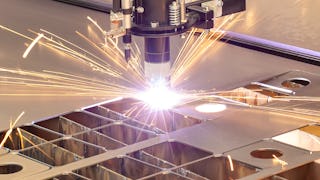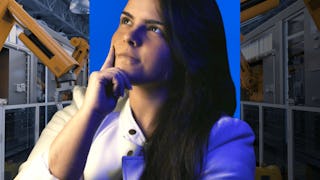Manufacturers are increasingly utilizing machine tools that are self-aware – they perceive their own states and the state of the surrounding environment – and are able to make decisions related to machine activity processes. This is called intelligent machining, and through this course students will receive a primer on its background, tools and related terminology.



Intelligent Machining
This course is part of Digital Manufacturing & Design Technology Specialization

Instructor: Rahul Rai
31,070 already enrolled
Included with 
(1,376 reviews)
Skills you'll gain
Details to know

Add to your LinkedIn profile
16 assignments
See how employees at top companies are mastering in-demand skills

Build your subject-matter expertise
- Learn new concepts from industry experts
- Gain a foundational understanding of a subject or tool
- Develop job-relevant skills with hands-on projects
- Earn a shareable career certificate

There are 4 modules in this course
The purpose of this module is to introduce the concepts related to intelligent machining paradigm. The key focus will be discussing two key components of intelligent machining, i.e., sensing and control.
What's included
4 videos4 readings4 assignments
The purpose of this module is to introduce spectrum of sensors used to implement intelligent machining. The module will also discuss the basics of signal processing and analysis techniques that has brought intelligent machining paradigm closer to industrial realization. Following issues pertaining to sensors and sensing techniques will be elaborated up: (1) Which sensors are to be used in each application? (2) How to acquire and process sensor signals?
What's included
4 videos3 readings5 assignments1 discussion prompt
The purpose of this module is to introduce the concept of Programmable Logic Controllers (PLCs) that co-ordinate the real-time control functions.
What's included
4 videos4 readings5 assignments
The purpose of this module is to introduce the background related to open architecture software systems to implement intelligent machining.
What's included
3 videos5 readings2 assignments1 discussion prompt
Earn a career certificate
Add this credential to your LinkedIn profile, resume, or CV. Share it on social media and in your performance review.
Instructor

Explore more from Mechanical Engineering
 Status: Free Trial
Status: Free Trial
University at Buffalo
 Status: Free Trial
Status: Free Trial
University at Buffalo
 Status: Free Trial
Status: Free Trial
Board Infinity
Why people choose Coursera for their career




Learner reviews
1,376 reviews
- 5 stars
71.80%
- 4 stars
22.09%
- 3 stars
4.14%
- 2 stars
1.01%
- 1 star
0.94%
Showing 3 of 1376
Reviewed on Jun 7, 2020
Very good and Interesting course Intelligent Machining .Gives you greatly overall knowledge about machining and manufacturing.
Reviewed on May 28, 2020
It was a good experience in their course which is very useful also give the information how the used of intelligent machining in industry
Reviewed on Aug 30, 2020
Interestingly, while watching the course content it feels like I am watching a documentation video. But the course is too short. I think It's just an intro to intelligent machining.

Open new doors with Coursera Plus
Unlimited access to 10,000+ world-class courses, hands-on projects, and job-ready certificate programs - all included in your subscription
Advance your career with an online degree
Earn a degree from world-class universities - 100% online
Join over 3,400 global companies that choose Coursera for Business
Upskill your employees to excel in the digital economy
Frequently asked questions
Access to lectures and assignments depends on your type of enrollment. If you take a course in audit mode, you will be able to see most course materials for free. To access graded assignments and to earn a Certificate, you will need to purchase the Certificate experience, during or after your audit. If you don't see the audit option:
The course may not offer an audit option. You can try a Free Trial instead, or apply for Financial Aid.
The course may offer 'Full Course, No Certificate' instead. This option lets you see all course materials, submit required assessments, and get a final grade. This also means that you will not be able to purchase a Certificate experience.
When you enroll in the course, you get access to all of the courses in the Specialization, and you earn a certificate when you complete the work. Your electronic Certificate will be added to your Accomplishments page - from there, you can print your Certificate or add it to your LinkedIn profile. If you only want to read and view the course content, you can audit the course for free.
If you subscribed, you get a 7-day free trial during which you can cancel at no penalty. After that, we don’t give refunds, but you can cancel your subscription at any time. See our full refund policy.
More questions
Financial aid available,





